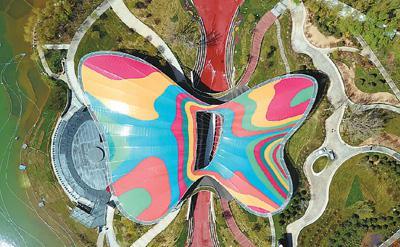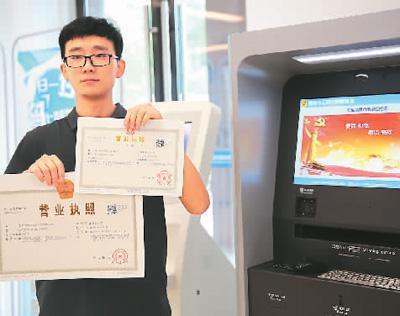

China has rolled out a great number of favorable policies and measures pertaining to further promotion of reform and opening-up in various fields and for this purpose has hosted multiple international events during 2019. This has brought about rich results for Chinese people, facilitated international cooperation and also demonstrated the country's resolve to continue carrying forward furthermore reform and opening-up initiatives.
China's reforms will never stop, and its doors will only open ever wider, according to Chinese President Xi Jinping during his New Year’s speech on Jan.1, 2019 which attracted wide attention from the world. Looking back at the year, China has delivered on its promises and opened up greater development space by effectively leveraging its key move of reform and opening-up.

Aerial photo shows the Guirui Theater at the 2019 Beijing International Horticultural Exhibition. (Photo by Chen Yehua/Xinhua)
Clearer top-level design
On Oct.28, the 19th Central Committee of the Communist Party of China (CPC) kicked off its fourth plenary session in Beijing. The session adopted the CPC Central Committee’s decision on major issues concerning how to uphold and improve the system of socialism with Chinese characteristics and advance the modernization of China’s system and capacity for governance.
The decision involves more than 200 major measures for deepening reforms in various fields. Full implementation and fulfillment of these major measures and important tasks will effectively promote the transfer of institutional advantages found in China into instances of governance efficiency, said Shi Zhihong, former vice director of the Policy Research Office of the CPC Central Committee.
In 2019, China rolled out a series of programmatic documents for reforms in various areas, including education, protection of intellectual property rights, integrated urban-rural development, international trade, and market access for private companies.

The “water bus” connecting Shenzhen airport terminal and Jiuzhou port in Zhuhai City, south China’s Guangdong Province, was officially put into service on Apr.26. With the opening of the new routes, people can now travel by sea from Shenzhen airport terminal to four cities in the Guangdong-Hong Kong-Macao Greater Bay Area, including Hong Kong, Macao, Zhongshan, and Zhuhai. (Photo by Mao Siqian/Xinhua)
During this year, China has released multiple development plans to boost regional develop, such as the Outline Development Plan for the Guangdong-Hong Kong-Macao Greater Bay Area and the outline of the integrated regional development of the Yangtze River Delta.
Under the guidance of national strategies, a new landscape of reform and opening-up has taken shape in China. Today, China sees coordinated efforts to promote the integrated regional development of the Yangtze River Delta, the joint construction of the Belt and Road Initiative (BRI), synergetic development of the Beijing-Tianjin-Hebei region, the development of the Yangtze River Economic Belt, and the construction of the Guangdong-Hong Kong-Macao Greater Bay Area.
Heartwarming measures in reforms
This November, a short video showing price negotiation between experts of China’s National Healthcare Security Administration (NHSA) and representatives of a pharmaceutical company went viral on the Internet.
The video footage demonstrates that experts of the NHSA have bargained with representatives of a drug company over the price of a drug for diabetes named Dapagliflozin Tablets, and managed to cut the price from 5.62 yuan (about $0.8) to 4.36 yuan after several rounds of discussions.
The bargaining has been spread across the Internet and widely applauded by netizens around the country, with many people feeling deeply touched to see how officials have tried their best to bring even more benefits to the public.
In fact, the experts that appear in the video successfully reached agreements with pharmaceutical companies on the prices of 97 among 150 types of drugs that were discussed during the negotiation process. All the 97 drugs have been included in China’s national medical insurance catalog.

Photo taken on Aug.13 shows a citizen surnamed Gao receives his business license via a smart online registration system for enterprises on the day when the system is launched at Qingdao Qianwan Bonded Port Area in Qingdao City, east China’s Shandong Province. (Photo by Zhang Jingang/People’s Daily)
The country has brought far more good news to its people during this year.
In 2019, China increased its per capita financial aid standard for medical insurance by 30 yuan, and the reimbursement rate of series disease insurance from 50 percent to 60 percent.
The country increased the basic old-age pension standard for retirees of enterprises and public institutions by about 5 percent, marking the 15th consecutive rise.
China has also made continued efforts to improve the business environment and energize the market, slashing taxes and fees to reduce the burden and pressure on market entities and taking a great number of measures to streamline administration, delegate power, improve compliance oversight and provide better services for all market players.
Starting from Jan. 1, China has put into practice a new system for calculating individual income tax in an effort to reduce tax burden for citizens who have certain expenditures.
A total of six special additional deductions were included in the new system, covering expenditures on caring for the elderly, children’s education, continuing education, treatment for serious diseases, as well as housing loan interest and rent amongst others.
Opening China’s doors wider to the world
China adopted the foreign investment law during the second session of the 13th National People’s Congress (NPC) this March. Highlighting full implementation of a management system combining pre-establishment national treatment as well as a negative list, the foreign investment law, which will take effect on Jan.1, 2020, is expected to provide better protection and business environment for foreign investors.

A staff member at the Saudi Arabia pavilion at the second CIIE shows jams from Saudi Arabia, Nov.7. (Photo by Chen Fei/Xinhua)
In 2019, China set up six more new pilot free trade zones in many different provinces including Shandong, Jiangsu, Guangxi, Hebei, Yunnan, and Heilongjiang, increasing its number of pilot free trade zones to 18. These zones located around the country have become new driving forces for reform and opening-up in the new era.
Besides improving the business environment of the Chinese market, the country has also endeavored to expand imports and promote international cooperation during this year.
This April, the 2019 Beijing International Horticultural Exhibition kicked off in Yanqing District of Beijing, attracting 110 countries and international organizations and more than 120 non-governmental exhibitors from around the world. The number of exhibitors at the event marked the highest number of exhibitors in the history of the exhibition.
This November, China hosted the second China International Import Expo (CIIE) in east China’s Shanghai, witnessing extensive participation and enormous fruits.
A total of over 500,000 visitors, more than 3,800 exhibiting companies, and 181 countries, regions, and international organizations registered for the event. The value of tentative deals reached during the expo for one-year purchases of goods and services reached $71.1 billion, 23 percent more than that sealed during the first CIIE.
A lot more international conferences and forums have been held in China during 2019, including the Understanding China Conference and the second Belt and Road Forum on International Cooperation. These international events yielded a rich variety of practical outcomes, significantly boosting understanding among different people around the world as well as international cooperation.
By November 2019, the number of members of the Asian Infrastructure Investment Bank (AIIB) exceeded 100, and the numbers of countries and international organizations that signed cooperation documents with China on the joint construction of the BRI had risen to 137 and 30 respectively.
The warm responses to China’s proposals and initiatives are the results of China’s idea and logic of sharing opportunities and fruits with the world.
It’s believed that China will continue taking major measures to deepen institutional and structural reforms in various fields and promote higher-level opening-up in the coming year.
 Fire brigade in Shanghai holds group wedding
Fire brigade in Shanghai holds group wedding Tourists enjoy ice sculptures in Datan Town, north China
Tourists enjoy ice sculptures in Datan Town, north China Sunset scenery of Dayan Pagoda in Xi'an
Sunset scenery of Dayan Pagoda in Xi'an Tourists have fun at scenic spot in Nanlong Town, NW China
Tourists have fun at scenic spot in Nanlong Town, NW China Harbin attracts tourists by making best use of ice in winter
Harbin attracts tourists by making best use of ice in winter In pics: FIS Alpine Ski Women's World Cup Slalom
In pics: FIS Alpine Ski Women's World Cup Slalom Black-necked cranes rest at reservoir in Lhunzhub County, Lhasa
Black-necked cranes rest at reservoir in Lhunzhub County, Lhasa China's FAST telescope will be available to foreign scientists in April
China's FAST telescope will be available to foreign scientists in April "She power" plays indispensable role in poverty alleviation
"She power" plays indispensable role in poverty alleviation Top 10 world news events of People's Daily in 2020
Top 10 world news events of People's Daily in 2020 Top 10 China news events of People's Daily in 2020
Top 10 China news events of People's Daily in 2020 Top 10 media buzzwords of 2020
Top 10 media buzzwords of 2020 Year-ender:10 major tourism stories of 2020
Year-ender:10 major tourism stories of 2020 No interference in Venezuelan issues
No interference in Venezuelan issues
 Biz prepares for trade spat
Biz prepares for trade spat
 Broadcasting Continent
Broadcasting Continent Australia wins Chinese CEOs as US loses
Australia wins Chinese CEOs as US loses